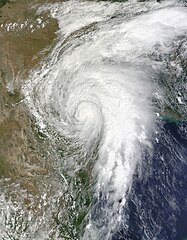Neutral ENSO by June is the headline of this update.The question is,will Neutral prevail thru all the Summer and Fall.
http://www.cpc.ncep.noaa.gov/products/a ... odisc.html
Synopsis: ENSO-neutral conditions are expected by June 2011.
La Niña continued to weaken during February 2011 as reflected by the reduced strength of the negative surface and near-surface temperature anomalies across much of the equatorial Pacific Ocean (Fig. 1 and Fig. 4). The Niño indices were between –0.5oC and –1.3oC at the end of February (Fig. 2). Subsurface oceanic heat content anomalies (average temperatures in the upper 300m of the ocean, Fig. 3) returned to near zero in response to the eastward progression of a strong oceanic Kelvin wave, which has weakened the negative temperature anomalies at depth in the central and eastern equatorial Pacific (Fig. 4). La Niña continued to be most evident in the atmospheric circulation over the equatorial Pacific, although at lesser intensity. Convection remained enhanced over much of Indonesia and suppressed over the western and central equatorial Pacific (Fig. 5). Also, anomalous low-level easterly and upper-level westerly winds have persisted in this region. However, a reduction in the strength of the anomalous low-level cross-equatorial flow, and associated oceanic upwelling, over the eastern Pacific contributed to anomalous SST warming in that region. Collectively, these oceanic and atmospheric anomalies reflect a weakening La Niña.
In concurrence with the observed evolution, nearly all of the ENSO models predict La Niña to weaken further in the coming months (Fig. 6). While the majority of models predict a return to ENSO-neutral by May-June-July 2011 (three month average in the Nino-3.4 index between –0.5oC and +0.5C), there continues to be large uncertainty in the status of ENSO through the Northern Hemisphere summer and fall. Due to both model and observed trends, there is increasing confidence in ENSO-neutral conditions by June 2011. However, model forecasts issued in the spring typically have minimum skill (the “spring barrier”), which results in low confidence forecasts for summer and beyond.
La Niña will continue to have global impacts even as the episode weakens through the Northern Hemisphere Spring. Expected La Niña impacts during March-May 2011 include suppressed convection over the west-central tropical Pacific Ocean, and enhanced convection over Indonesia. Potential impacts in the United States include an enhanced chance of below-average precipitation across much of the southern states and the Central Rockies and Central Plains. An increased chance of below-average temperatures is predicted for much of the West Coast and across the northern tier of states (excluding New England). A higher possibility of above-average temperatures is favored for much of the southern half of the contiguous U.S. (see 3-month seasonal outlook released on February 17th, 2011).

















